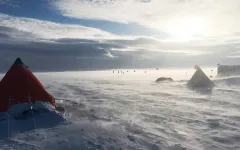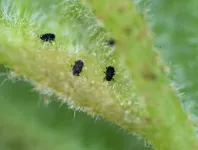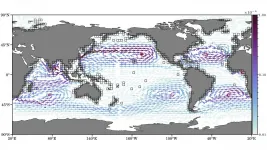New study finds atmospheric rivers increase snow mass in West Antarctica
New satellite enabled detailed measurement of extreme precipitation events
2021-03-02
(Press-News.org) A new study published today in the journal Geophysical Research Letters used NASA's ice-measuring laser satellite to identify atmospheric river storms as a key driver of increased snowfall in West Antarctica during the 2019 austral winter.
These findings from scientists at Scripps Institution of Oceanography at the University of California San Diego and colleagues will help improve overall understanding of the processes driving change in Antarctica, and lead to better predictions of sea-level rise. The study was funded by NASA, with additional support from the Rhodium Group's Climate Impact Lab, a consortium of leading research institutions examining the risks of climate change.
Atmospheric rivers are phenomena that transport large amounts of water vapor in long, narrow "rivers" in the sky. They are known to be the main driver of precipitation along the West Coast of the United States, accounting for 25-50 percent of annual precipitation in key parts of the West. Increasing research on atmospheric rivers finds that they dominantly impact the western coasts of most continents, due to oceans evaporating and storms building high levels of moisture into the atmosphere.
NASA's Ice, Cloud, and land Elevation Satellite-2 (ICESat-2), launched into orbit in September 2018, is providing a detailed look at the height of ice and snow on the vast, frozen continent. The satellite works by sending 10,000 laser pulses per second to Earth's surface that measure the height of ice sheets, glaciers, and more by calculating the time it takes a handful of those pulses to return to the satellite. Each photon of light has a time tag, and these tags combine with the GPS location to pinpoint its exact place and height on the ground. It measures a detailed set of tracks over the Antarctic ice sheet every three months.
"ICESat-2 is the first satellite to be able to measure snowfall over the Antarctic continent in such a precise way," said Helen Amanda Fricker, a glaciologist at Scripps Oceanography and co-author of the study. "In winter, weather conditions prohibit having a field team there making observations on the ground. ICESat-2 is filling in this lack of data over the vast ice sheets, and giving us a greater understanding of snow mass gain and loss on a seasonal scale."
Looking at ICESat-2 data, scientists found increases in height over the Antarctic Ice Sheet between April 2019 and June 2020 due to increased snowfall. Using a computational model of the atmosphere and snow, they found that 41 percent of height increases over West Antarctica during the 2019 winter occurred because intermittent extreme precipitation events delivered large quantities of snow during short periods of time. Of those events, 63 percent were identified as landfalling atmospheric rivers. These systems were distinguished from other storms by the much higher moisture levels measured in the lower portions of the atmosphere.
The atmospheric rivers making landfall in Antarctica originate in the sub-tropical, mid-latitudes of the Southern Hemisphere. They travel long distances with no continents to stop them, eventually making landfall in West Antarctica.
"We know the frequency of atmospheric rivers is expected to increase, so it's important that scientists are able to measure how much they are contributing to snow mass increase or surface melting," said Susheel Adusumilli, lead author and PhD candidate at Scripps Oceanography. "Knowing how much snow is being accumulated across the continent helps us better understand how mass is changing as a whole, and informs our understanding of sea-level rise potential from the Antarctic Ice Sheet."
More than one hundred gigatons of ice are being lost to the ocean from Antarctica each year, contributing to ongoing sea-level rise. Most of this ice loss is driven by increased ice flow into the ocean from the melting of the floating ice shelves that surround Antarctica. Understanding the balance of mass gains from snowfall in the interior of Antarctica and mass loss from ocean warming is key to improving projections of sea-level rise.
While this study tracked ice mass in the short term, atmospheric rivers in Antarctica can also drive large amounts of snowmelt. In fact, this study found that around 90 percent of summer atmospheric rivers and 10 percent of winter atmospheric rivers coincided with potential surface melt over the West Antarctic Ice Sheet. Atmospheric river-driven melting is due to the low clouds from these systems, which can absorb and re-emit heat back to the surface. Scientists will need further study to understand if these events will be snow makers or melters, looking at factors such as seasonality, moisture level, cloud coverage, or if each is storm dependent.
"In the U.S., scientists study atmospheric rivers and look at if they might be beneficial for water supply in California or hazardous, causing flooding," said study co-author Meredith Fish, postdoctoral associate at Rutgers University and alumna of Scripps Oceanography, where she studied at the Center for Western Weather and Water Extremes. "What's interesting in Antarctica is the question, are atmospheric rivers going to contribute to snowmelt or snow accumulation?"
INFORMATION:
[Attachments] See images for this press release:

ELSE PRESS RELEASES FROM THIS DATE:
2021-03-02
CLEVELAND - Researchers from Cleveland Clinic's Global Center for Pathogen Research & Human Health have developed a promising new COVID-19 vaccine candidate that utilizes nanotechnology and has shown strong efficacy in preclinical disease models.
According to new findings published in mBio, the vaccine produced potent neutralizing antibodies among preclinical models and also prevented infection and disease symptoms in the face of exposure to SARS-CoV-2 (the virus that causes COVID-19). An additional reason for the vaccine candidate's early appeal is that it may be thermostable, which would make it easier to transport and store than currently authorized COVID-19 ...
2021-03-02
There's more to taste than flavor. Let ice cream melt, and the next time you take it out of the freezer you'll find its texture icy instead of the smooth, creamy confection you're used to. Though its flavor hasn't changed, most people would agree the dessert is less appetizing.
UC Santa Barbara Professor Craig Montell and postdoctoral fellow Qiaoran Li have published a study in Current Biology providing the first description of how certain animals sense the texture of their food based on grittiness versus smoothness. They found that, in fruit flies, a mechanosensory channel relays this information about a food's texture.
The channel, called TMEM63, is part of ...
2021-03-02
UPTON, NY--Physically confined spaces can make for more efficient chemical reactions, according to recent studies led by scientists from the U.S. Department of Energy's (DOE) Brookhaven National Laboratory. They found that partially covering metal surfaces acting as catalysts, or materials that speed up reactions, with thin films of silica can impact the energies and rates of these reactions. The thin silica forms a two-dimensional (2-D) array of hexagonal-prism-shaped "cages" containing silicon and oxygen atoms.
"These porous silica frameworks are the thickness of only three atoms," explained Samuel Tenney, a chemist in the Interface Science and ...
2021-03-02
AMES, Iowa - Vaccines are an important tool in fighting porcine reproductive and respiratory syndrome (PRRS), but the fast-mutating virus that causes the disease sometimes requires the production of autogenous vaccines tailored to particular variants.
The production of autogenous vaccines depends on the ability of scientists to isolate the virus, but sometimes that's a tricky process. A new study from an Iowa State University researcher shows that a new cell line may offer a better alternative to the cell line most commonly used to isolate the PRRS virus. That could lead to more reliable processes for creating autogenous vaccines, but most autogenous vaccine producers would have to make dramatic changes to their processes ...
2021-03-02
For nearly a century, improvement in human healthcare has depended heavily on the efficiency with which we can treat bacterial diseases. But today, antibiotic resistance--the ability of certain mutant super-bacteria to block out antibiotics--poses a major threat to healthcare, food security, and overall social development worldwide, threatening to upend much of the progress our civilization has achieved.
Scientists are now urgently attempting to tackle this problem from various angles. Professor Yunho Lee at Gwangju Institute of Science and Technology (GIST), Korea, whose contribution is published in the American Chemical Society's Environmental Science and Technology, is looking at it from the point of view of his field of research--wastewater ...
2021-03-02
If you're looking for an indoor space with a low level of particulate air pollution, a commercial airliner flying at cruising altitude may be your best option. A newly reported study of air quality in indoor spaces such as stores, restaurants, offices, public transportation -- and commercial jets -- shows aircraft cabins with the lowest levels of tiny aerosol particles.
Conducted in July 2020, the study included monitoring both the number of particles and their total mass across a broad range of indoor locations, including 19 commercial flights in which measurements took place throughout ...
2021-03-02
Finding innovative and sustainable solutions to our material needs is one of the core objectives of green chemistry. The myriad plastics that envelop our daily life - from mattresses to food and cars - are mostly made from oil-based monomers which are the building blocks of polymers. Therefore, finding bio-based monomers for polymer synthesis is attractive to achieve more sustainable solutions in materials development.
In a paper published in ACS Sustainable Chemistry & Engineering, researchers from the Kleij group present a new route to prepare biobased polyesters with tuneable properties. The researchers ...
2021-03-02
Insects can reprogram plant growth, transforming ordinary plant parts into intricately patterned shelters that are safe havens for feeding and reproduction.
These structures, called galls, have fascinated biologists for centuries. They're crafted by a variety of insects, including some species of aphids, mites, and wasps. And they take on innumerable forms, each specific in shape and size to the insect species that's created it - from knobs to cone-shaped protrusions to long, thin spikes. Some even resemble flowers.
Insects create galls by manipulating the development of plants, but figuring out exactly how they perform this feat "feels like ...
2021-03-02
The backbone is the Swiss Army Knife of mammal locomotion. It can function in all sorts of ways that allows living mammals to have remarkable diversity in their movements. They can run, swim, climb and fly all due, in part, to the extensive reorganization of their vertebral column, which occurred over roughly 320 million years of evolution.
Open any anatomy textbook and you'll find the long-standing hypothesis that the evolution of the mammal backbone, which is uniquely capable of sagittal (up and down) movements, evolved from a backbone that functioned ...
2021-03-02
WASHINGTON, March 2, 2021 -- Tons of plastic debris get released into the ocean every day, and most of it accumulates within the middle of garbage patches, which tend to float on the oceans' surface in the center of each of their regions. The most infamous one, known as the Great Pacific Garbage Patch, is in the North Pacific Ocean.
Researchers in the U.S. and Germany decided to explore which pathways transport debris from the coasts to the middle of the oceans, as well as the relative strengths of different subtropical gyres in the oceans and how they influence long-term accumulation of debris.
In Chaos, from AIP Publishing, Philippe Miron, Francisco Beron-Vera, Luzie Helfmann, and Peter Koltai report creating a Markov chain ...
LAST 30 PRESS RELEASES:
[Press-News.org] New study finds atmospheric rivers increase snow mass in West Antarctica
New satellite enabled detailed measurement of extreme precipitation events









